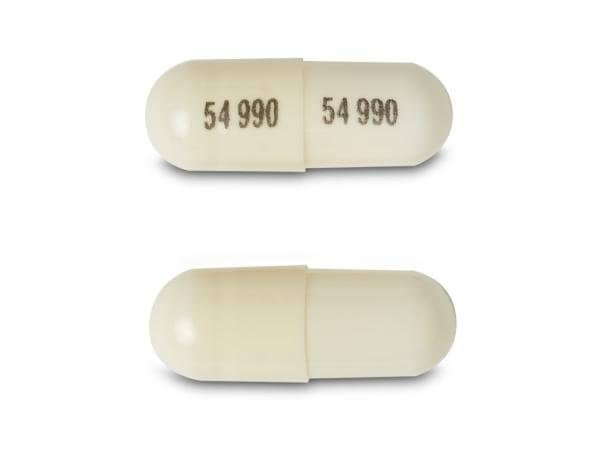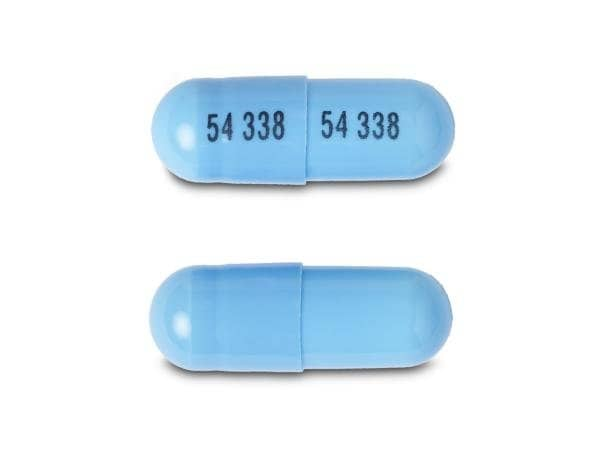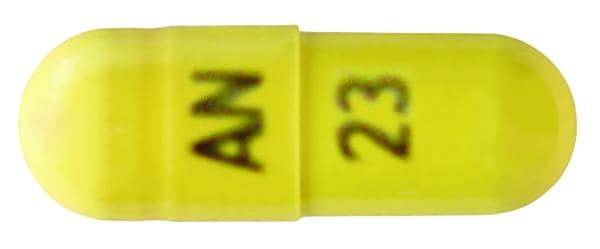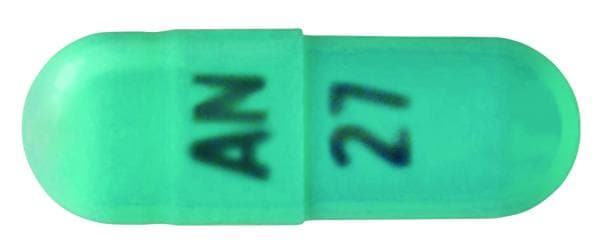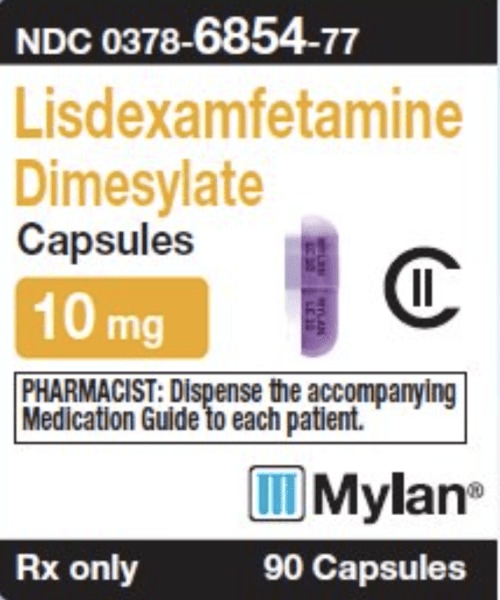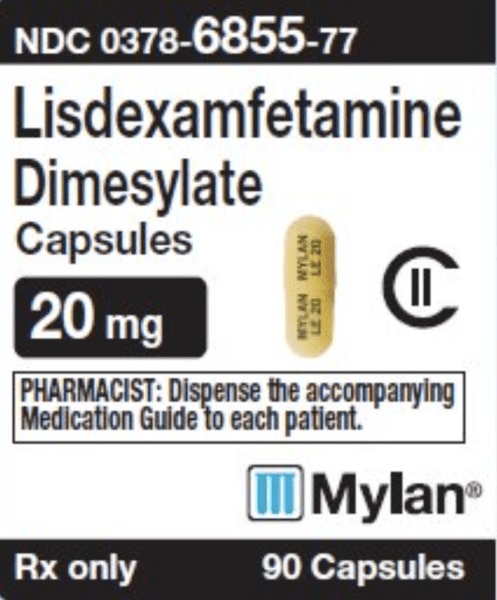Boxed Warning
Abuse and dependence:
CNS stimulants (amphetamines and methylphenidate-containing products), including lisdexamfetamine, have a high potential for abuse and dependence. Assess the risk of abuse prior to prescribing and monitor for signs of abuse and dependence while on therapy.
Dosage Forms
Excipient information presented when available (limited, particularly for generics); consult specific product labeling.
Capsule, Oral, as dimesylate:
Vyvanse: 10 mg
Vyvanse: 20 mg, 30 mg [contains brilliant blue fcf (fd&c blue #1), fd&c yellow #6 (sunset yellow)]
Vyvanse: 40 mg, 50 mg, 60 mg [contains brilliant blue fcf (fd&c blue #1)]
Vyvanse: 70 mg [contains brilliant blue fcf (fd&c blue #1), fd&c yellow #6 (sunset yellow)]
Tablet Chewable, Oral, as dimesylate:
Vyvanse: 10 mg, 20 mg, 30 mg, 40 mg, 50 mg, 60 mg
Pharmacology
Mechanism of Action
The exact mechanism of lisdexamfetamine in ADHD and binge eating disorder is not known. Lisdexamfetamine dimesylate is a prodrug that is converted to the active component dextroamphetamine (a noncatecholamine, sympathomimetic amine). Amphetamines are noncatecholamine, sympathomimetic amines that cause release of catecholamines (primarily dopamine and norepinephrine) from their storage sites in the presynaptic nerve terminals. A less significant mechanism may include their ability to block the reuptake of catecholamines by competitive inhibition.
Pharmacokinetics/Pharmacodynamics
Absorption
Rapid
Metabolism
Metabolized in the blood by hydrolytic activity of red blood cells to dextroamphetamine and l-lysine; does not undergo CYP mediated metabolism
Excretion
Urine (96%, 42% as amphetamine-related compounds, 2% as lisdexamfetamine, 25% hippuric acid); feces (minimal)
Time to Peak
Capsule: Tmax: Lisdexamfetamine: Children 6 to 12 years: 1 hour (fasting); Adults: ~1 hour; Dextroamphetamine: Children 6 to 12 years: 3.5 hours (fasting); Adults: 3.8 hours (fasting), 4.7 hours (after a high-fat meal)
Chewable tablet: Tmax: Lisdexamfetamine: 1 hour (fasting); Dextroamphetamine: 3.9 to 4.4 hours (fasting); 4.9 hours (after a high-fat meal)
Duration of Action
8 to 14 hours (Jain 2017)
Half-Life Elimination
Lisdexamfetamine: <1 hour; Dextroamphetamine: 10 to 13 hours
Use in Specific Populations
Special Populations: Renal Function Impairment
Mean dextroamphetamine clearance was reduced from 0.7 L/hour/kg to 0.4 L/hour/kg with severe renal impairment (GFR 15 to <30 mL/minute/1.73 m2) and to 0.3 L/hour/kg with ESRD.
Use: Labeled Indications
Attention-deficit/hyperactivity disorder: Treatment of attention-deficit/hyperactivity disorder (ADHD).
Binge eating disorder: Treatment of moderate to severe binge eating disorder in adults.
Contraindications
Hypersensitivity to amphetamine products or any component of the formulation; concurrent use of MAO inhibitor, or within 14 days of the last MAO inhibitor dose.
Canadian labeling: Additional contraindications (not in US labeling): Known hypersensitivity or idiosyncrasy to sympathomimetic amines; advanced arteriosclerosis; symptomatic cardiovascular disease; moderate-to-severe hypertension; hyperthyroidism; glaucoma; agitated states; history of drug abuse
Dosage and Administration
Dosing: Adult
Note: Prior to treatment, assess for presence of cardiac disease and assess for risk of abuse.
Attention-deficit/hyperactivity disorder (ADHD): Oral: Initial: 30 mg once daily in the morning; may increase in increments of 10 mg or 20 mg at weekly intervals until optimal response is obtained; maximum: 70 mg/day. Note: Individualize dosage based on patient need and response to therapy. Administer at the lowest effective dose.
Binge eating disorder: Oral: Initial: 30 mg once daily in the morning; may titrate in increments of 20 mg at weekly intervals to target dose of 50 to 70 mg once daily (maximum: 70 mg/day); discontinue use if binge eating does not improve.
Dosing: Geriatric
Refer to adult dosing; initiate dose at the low end of the dosing range.
Dosing: Pediatric
Note: Use lowest effective individualized dose; administer first dose as soon as awake; avoid late evening doses.
Attention-deficit/hyperactivity disorder (ADHD): Children ≥6 years and Adolescents: Capsules, chewable tablets: Oral: Initial: 20 to 30 mg once daily in the morning; may increase in increments of 10 mg/day or 20 mg/day at 3- to 7-day intervals until optimal response is obtained; maximum daily dose: 70 mg/day (AAP 2011; manufacturer labeling)
Binge eating disorder, moderate to severe: Adolescents ≥18 years: Capsule, chewable tablets: Oral: Initial: 30 mg once daily in the morning; may titrate in increments of 20 mg/day at weekly intervals to target dose of 50 to 70 mg once daily; maximum daily dose: 70 mg/day; discontinue use if binge eating does not improve.
Administration
Administer in the morning without regard to meals; avoid afternoon doses because of potential for insomnia. Do not take less than one capsule or chewable tablet per day; a single dose should not be divided.
Capsules: Swallow capsule whole, do not chew. Capsule may be opened and the entire contents mixed with water, yogurt, or orange juice; stir until dispersed completely and consume the entire mixture immediately; do not store mixture. The active ingredient dissolves completely once dispersed; however, a film containing the inactive ingredients may remain in the glass or container once the mixture is consumed.
Chewable tablets: Chew thoroughly before swallowing.
Storage
Store at 20°C to 25°C (68°F to 77°F); excursions are permitted between 15°C and 30°C (59°F and 86°F). Protect from light.
Lisdexamfetamine Images
Drug Interactions
Acebrophylline: May enhance the stimulatory effect of CNS Stimulants. Avoid combination
Alkalinizing Agents: May decrease the excretion of Amphetamines. Management: Consider alternatives to using amphetamines and alkalinizing agents in combination. If these agents must be used together, patients should be monitored closely for excessive amphetamine effects. Consider therapy modification
Amifampridine: Agents With Seizure Threshold Lowering Potential may enhance the neuroexcitatory and/or seizure-potentiating effect of Amifampridine. Monitor therapy
Ammonium Chloride: May decrease the serum concentration of Amphetamines. This effect is likely due to an enhanced excretion of amphetamines in the urine. Monitor therapy
Antacids: May decrease the excretion of Amphetamines. Monitor therapy
Antihistamines: Amphetamines may diminish the sedative effect of Antihistamines. Monitor therapy
Antihypertensive Agents: Amphetamines may diminish the antihypertensive effect of Antihypertensive Agents. Monitor therapy
Antipsychotic Agents: May diminish the stimulatory effect of Amphetamines. Monitor therapy
Ascorbic Acid: May decrease the serum concentration of Amphetamines. Monitor therapy
AtoMOXetine: May enhance the hypertensive effect of Sympathomimetics. AtoMOXetine may enhance the tachycardic effect of Sympathomimetics. Monitor therapy
BuPROPion: May enhance the neuroexcitatory and/or seizure-potentiating effect of Agents With Seizure Threshold Lowering Potential. Monitor therapy
Cannabinoid-Containing Products: May enhance the tachycardic effect of Sympathomimetics. Exceptions: Cannabidiol. Monitor therapy
Carbonic Anhydrase Inhibitors: May decrease the excretion of Amphetamines. Exceptions: Brinzolamide; Dorzolamide. Monitor therapy
Cocaine (Topical): May enhance the hypertensive effect of Sympathomimetics. Management: Consider alternatives to use of this combination when possible. Monitor closely for substantially increased blood pressure or heart rate and for any evidence of myocardial ischemia with concurrent use. Consider therapy modification
CYP2D6 Inhibitors (Moderate): May increase the serum concentration of Amphetamines. Monitor therapy
CYP2D6 Inhibitors (Strong): May increase the serum concentration of Amphetamines. Exceptions: FLUoxetine; PARoxetine. Monitor therapy
Doxofylline: Sympathomimetics may enhance the adverse/toxic effect of Doxofylline. Monitor therapy
Esketamine: May enhance the hypertensive effect of CNS Stimulants. Monitor therapy
Ethosuximide: Amphetamines may diminish the therapeutic effect of Ethosuximide. Amphetamines may decrease the serum concentration of Ethosuximide. Monitor therapy
Gastrointestinal Acidifying Agents: May decrease the serum concentration of Amphetamines. Monitor therapy
Guanethidine: May enhance the arrhythmogenic effect of Sympathomimetics. Guanethidine may enhance the hypertensive effect of Sympathomimetics. Monitor therapy
Iobenguane Radiopharmaceutical Products: Amphetamines may diminish the therapeutic effect of Iobenguane Radiopharmaceutical Products. Management: Discontinue all drugs that may inhibit or interfere with catecholamine transport or uptake for at least 5 biological half-lives before iobenguane administration. Do not administer these drugs until at least 7 days after each iobenguane dose. Avoid combination
Iobenguane Radiopharmaceutical Products: CNS Stimulants may diminish the therapeutic effect of Iobenguane Radiopharmaceutical Products. Management: Discontinue all drugs that may inhibit or interfere with catecholamine transport or uptake for at least 5 biological half-lives before iobenguane administration. Do not administer these drugs until at least 7 days after each iobenguane dose. Avoid combination
Ioflupane I 123: Amphetamines may diminish the diagnostic effect of Ioflupane I 123. Monitor therapy
Iohexol: Agents With Seizure Threshold Lowering Potential may enhance the adverse/toxic effect of Iohexol. Specifically, the risk for seizures may be increased. Management: Discontinue agents that may lower the seizure threshold 48 hours prior to intrathecal use of iohexol. Wait at least 24 hours after the procedure to resume such agents. In nonelective procedures, consider use of prophylactic anticonvulsants. Consider therapy modification
Iomeprol: Agents With Seizure Threshold Lowering Potential may enhance the adverse/toxic effect of Iomeprol. Specifically, the risk for seizures may be increased. Management: Discontinue agents that may lower the seizure threshold 48 hours prior to intrathecal use of iomeprol. Wait at least 24 hours after the procedure to resume such agents. In nonelective procedures, consider use of prophylactic anticonvulsants. Consider therapy modification
Iopamidol: Agents With Seizure Threshold Lowering Potential may enhance the adverse/toxic effect of Iopamidol. Specifically, the risk for seizures may be increased. Management: Discontinue agents that may lower the seizure threshold 48 hours prior to intrathecal use of iopamidol. Wait at least 24 hours after the procedure to resume such agents. In nonelective procedures, consider use of prophylactic anticonvulsants. Consider therapy modification
Methenamine: May decrease the serum concentration of Amphetamines. This effect is likely due to an enhanced excretion of amphetamines in the urine. Monitor therapy
Monoamine Oxidase Inhibitors: May enhance the hypertensive effect of Amphetamines. While linezolid and tedizolid may interact via this mechanism, management recommendations differ from other monoamine oxidase inhibitors. Refer to monographs specific to those agents for details. Avoid combination
Multivitamins/Fluoride (with ADE): May decrease the serum concentration of Amphetamines. More specifically, the ascorbic acid (vitamin C) in many multivitamins may decrease amphetamine concentrations. Monitor therapy
Multivitamins/Minerals (with ADEK, Folate, Iron): May decrease the serum concentration of Amphetamines. Monitor therapy
Multivitamins/Minerals (with AE, No Iron): May decrease the serum concentration of Amphetamines. Specifically, vitamin C may impair absorption of amphetamines. Monitor therapy
Opioid Agonists: Amphetamines may enhance the analgesic effect of Opioid Agonists. Monitor therapy
PHENobarbital: Amphetamines may decrease the serum concentration of PHENobarbital. Monitor therapy
Phenytoin: Amphetamines may decrease the serum concentration of Phenytoin. Monitor therapy
Quinolones: Amphetamines may enhance the cardiotoxic effect of Quinolones. Monitor therapy
Selective Serotonin Reuptake Inhibitors (Strong CYP2D6 Inhibitors): Amphetamines may enhance the serotonergic effect of Selective Serotonin Reuptake Inhibitors (Strong CYP2D6 Inhibitors). This could result in serotonin syndrome. Selective Serotonin Reuptake Inhibitors (Strong CYP2D6 Inhibitors) may increase the serum concentration of Amphetamines. Management: Monitor for increased amphetamine toxicities, including signs and symptoms of serotonin syndrome/serotonin toxicity (eg, hyperreflexia, clonus, hyperthermia, diaphoresis, tremor, autonomic instability) when these agents are combined. Monitor therapy
Serotonergic Agents (High Risk): Amphetamines may enhance the serotonergic effect of Serotonergic Agents (High Risk). This could result in serotonin syndrome. Management: Monitor for signs and symptoms of serotonin syndrome/serotonin toxicity (eg, hyperreflexia, clonus, hyperthermia, diaphoresis, tremor, autonomic instability, mental status changes) when these agents are combined. Exceptions: Amitriptyline; Amoxapine; ClomiPRAMINE; Desipramine; Dothiepin; Doxepin (Systemic); Doxepin (Topical); FLUoxetine; Imipramine; Isocarboxazid; Linezolid; Lofepramine; Melitracen [INT]; Methylene Blue; Moclobemide; Nortriptyline; PARoxetine; Phenelzine; Protriptyline; Tranylcypromine; Trimipramine. Monitor therapy
Solriamfetol: Sympathomimetics may enhance the hypertensive effect of Solriamfetol. Monitor therapy
Solriamfetol: CNS Stimulants may enhance the hypertensive effect of Solriamfetol. Monitor therapy
Sympathomimetics: May enhance the adverse/toxic effect of other Sympathomimetics. Monitor therapy
Tedizolid: May enhance the hypertensive effect of Sympathomimetics. Tedizolid may enhance the tachycardic effect of Sympathomimetics. Monitor therapy
Tricyclic Antidepressants: May enhance the adverse/toxic effect of Amphetamines. Tricyclic Antidepressants may potentiate the cardiovascular effects of Amphetamines. Amphetamines may enhance the serotonergic effect of Tricyclic Antidepressants. This could result in serotonin syndrome. Management: Monitor for signs and symptoms of serotonin syndrome/serotonin toxicity (eg, hyperreflexia, clonus, hyperthermia, diaphoresis, tremor, autonomic instability, mental status changes) and increased cardiovascular effects when these agents are combined. Monitor therapy
Urinary Acidifying Agents: May decrease the serum concentration of Amphetamines. Monitor therapy
Test Interactions
Amphetamines may elevate plasma corticosteroid levels; may interfere with urinary steroid determinations.
Adverse Reactions
>10%:
Central nervous system: Insomnia (13% to 27%)
Gastrointestinal: Decreased appetite (children and adolescents 34% to 39%; adults 8% to 27%), xerostomia (adults: 26% to 36%; children and adolescents: 4% to 5%), upper abdominal pain (children: 12%; adults: 2%)
1% to 10%:
Cardiovascular: Increased heart rate (adults: 2% to 7%), increased blood pressure (adults: 3%), palpitations (2%)
Central nervous system: Irritability (children: 10%), anxiety (adults: 5% to 6%), jitteriness (adults: 4% to 6%), dizziness (children: 5%), agitation (adults: 3%), emotional lability (children: 3%), restlessness (adults: 2% to 3%), drowsiness (children: 2%), increased energy (adults: 2%), nightmares (adults: 2%), paresthesia (adults: 2%), tic disorder (children: 2%)
Dermatologic: Hyperhidrosis (adults: 3% to 4%), skin rash (children: 3%), pruritus (adults: 2%)
Endocrine & metabolic: Weight loss (children and adolescents: 9%; adults: 3% to 4%), decreased libido (adults: 2%)
Gastrointestinal: Vomiting (children: 9%; adults: 2%), diarrhea (adults: 4% to 7%), nausea (6% to 7%), constipation (adults: 6%), anorexia (2% to 5%), gastroenteritis (adults: 2%)
Genitourinary: Erectile dysfunction (adults: 3%), urinary tract infection (adults: 2%)
Neuromuscular & skeletal: Tremor (2%)
Respiratory: Dyspnea (adults: 2%), oropharyngeal pain (2%)
Miscellaneous: Fever (children: 2%)
Frequency not defined:
Central nervous system: Drug abuse, drug dependence, talkativeness
<1%, postmarketing, and/or case reports: Accommodation disturbance, aggressive behavior, alopecia, anaphylaxis, angioedema, blurred vision, bruxism, cardiomyopathy, chest pain, decreased linear skeletal growth rate, depression, dermatillomania, diplopia, dysgeusia, dyskinesia, frequent erections, hepatitis (eosinophilic), hypersensitivity condition, mydriasis, peripheral vascular insufficiency, prolonged erection, rhabdomyolysis, Raynaud's disease, seizure, Stevens-Johnson syndrome, urticaria
Warnings/Precautions
Concerns related to adverse effects:
- Cardiovascular events: Stimulant use has been associated with serious cardiovascular events including sudden death in patients with preexisting structural cardiac abnormalities or other serious heart problems (sudden death in children and adolescents; sudden death, stroke, and MI in adults). Consistent with other studies, a large retrospective cohort study involving 1,200,438 children, adolescents, and young adults (aged 2 to 24 years) prescribed methylphenidate, dexmethylphenidate, dextroamphetamines, amphetamine salts, pemoline, or atomoxetine found no evidence that current use of an ADHD medication increased risk for sudden cardiac death, acute MI, or stroke (Cooper 2011). Stimulants should be avoided in patients with known structural cardiac abnormalities, cardiomyopathy, serious heart rhythm abnormalities, coronary artery disease, Marfan syndrome, or other serious cardiac problems. Some products are contraindicated in patients with moderate or severe hypertension. Prior to initiating stimulant, assess medical history and family history of sudden death or ventricular arrhythmia; conduct a physical exam to assess for cardiac disease; patients should receive further evaluation if findings suggest cardiac disease, such as ECG and echocardiogram. Promptly conduct cardiac evaluation in patients who develop exertional chest pain, unexplained syncope, or any other symptoms of cardiac disease during stimulant treatment.
- CNS effects: Amphetamines may impair the ability to engage in potentially hazardous activities; patients must be cautioned about performing tasks which require mental alertness (eg, operating machinery or driving).
- Hypersensitivity: Hypersensitivity reactions, including anaphylaxis, Stevens-Johnson syndrome, angioedema, and urticaria have been observed.
- Peripheral vasculopathy: Stimulants are associated with peripheral vasculopathy, including Raynaud phenomenon; signs/symptoms are usually mild and intermittent, and generally improve with dose reduction or discontinuation. Peripheral vasculopathy effects have been observed at different times, at therapeutic doses, and in all age groups. Digital ulceration and/or soft tissue breakdown have been observed rarely; monitor for digital changes during therapy and seek further evaluation (eg, rheumatology) if necessary.
- Visual disturbance: Difficulty in accommodation and blurred vision has been reported with the use of stimulants.
Disease-related concerns:
- Cardiovascular disorders: CNS stimulants may increase heart rate and blood pressure; the observed mean increase in heart rate was 3 to 6 bpm and blood pressure was 2 to 4 mm Hg. Use with caution in patients with hypertension, heart failure, recent MI, ventricular arrhythmia, and other cardiovascular conditions that might be exacerbated by increases in blood pressure or heart rate. Some products are contraindicated in patients with moderate to severe hypertension or hyperthyroidism.
- Psychiatric disorders: Use with caution in patients with preexisting psychosis or bipolar disorder (may induce mixed/manic episode). May exacerbate symptoms of behavior and thought disorder in psychotic patients; new onset psychosis or mania may occur in children or adolescents with stimulant use. Patients should be screened for bipolar disorder and risk factors for developing mania prior to treatment; consider discontinuation if such symptoms (eg, delusional thinking, hallucinations, or mania) occur. May be associated with aggressive behavior or hostility (causal relationship not established); monitor for development or worsening of these behaviors.
- Seizure disorder: Limited information exists regarding stimulant use in seizure disorder. Whereas patients with ADHD are at an increased risk for seizure activity compared to the general population, a retrospective study using drug claims data showed that the use of stimulant medications was associated with a lower risk (Cortese 2013; Wiggs 2018). Manufacturers of some stimulants recommend discontinuing therapy if seizures occur.
- Tourette syndrome/tics: Use with caution in patients with Tourette syndrome or other tic disorders. Stimulants may exacerbate tics (motor and phonic) and Tourette syndrome; however, evidence demonstrating increased tics is limited. Evaluate for tics and Tourette syndrome prior to therapy initiation (AACAP [Murphy 2013]; Pliszka 2007).
Concurrent drug therapy issues:
- Drug-drug interactions: Potentially significant interactions may exist, requiring dose or frequency adjustment, additional monitoring, and/or selection of alternative therapy. Consult drug interactions database for more detailed information.
- Serotonin syndrome: Potentially life-threatening serotonin syndrome (SS) may occur when lisdexamfetamine is used in combination with other serotonergic agents (eg, selective serotonin reuptake inhibitors, serotonin norepinephrine reuptake inhibitors, triptans, tricyclic antidepressants, fentanyl, lithium, tramadol, buspirone, St. John's wort, tryptophan), agents that impair metabolism of serotonin (eg, monoamine oxidase inhibitors) or CYP2D6 inhibitors that impair metabolism of lisdexamfetamine. Concomitant use with monoamine oxidase inhibitors is contraindicated. If concomitant use of lisdexamfetamine with serotonergic drugs or CYP2D6 inhibitors is indicated, initiate lisdexamfetamine at a low dose and monitor patient closely for signs and symptoms of SS. Discontinue treatment (and any concomitant serotonergic agent) immediately if signs/symptoms arise.
Special populations:
- Elderly: Use caution in this age group due to CNS stimulant adverse effects.
- Pediatric: Appetite suppression may occur; particularly in children. Use of stimulants has been associated with weight loss and slowing of growth rate; monitor growth rate and weight during treatment. Treatment interruption may be necessary in patients who are not increasing in height or gaining weight as expected.
Other warnings/precautions:
- Abuse/misuse/diversion: [US Boxed Warning]: Has high potential for abuse and dependence; assess for abuse potential prior to use and monitor for signs of abuse and dependence while on therapy. Use with caution in patients with a history of ethanol or drug abuse. Prescriptions should be written for the smallest quantity consistent with good patient care to minimize possibility of overdose.
- ADHD treatment: Appropriate use: Recommended to be used as part of a comprehensive treatment program for attention deficit disorders.
- Weight loss: Appropriate use: Not indicated or recommended for weight loss; safety and efficacy not established for treatment of obesity.
- Discontinuation of therapy: Abrupt discontinuation following high doses or for prolonged periods may result in symptoms for withdrawal (eg, depression, extreme fatigue).
Monitoring Parameters
Cardiac evaluation should be completed at baseline and on any patient who develops exertional chest pain, unexplained syncope, and any symptom of cardiac disease during treatment with stimulants. Monitor blood pressure and heart rate (baseline, following dose increases and periodically during treatment); growth rate (height and weight) and appetite in children; weight in adults; signs of peripheral vasculopathy (eg, digital changes); sleep and behavioral changes. Assess for risk of abuse prior to prescribing and signs of misuse, abuse, or addiction throughout treatment (NICE 2018).
Pregnancy
Pregnancy Considerations
Lisdexamfetamine is converted to dextroamphetamine. The majority of human data is based on illicit amphetamine/methamphetamine exposure and not from therapeutic maternal use (Golub 2005). Use of amphetamines during pregnancy may lead to an increased risk of premature birth and low birth weight; newborns may experience symptoms of withdrawal. Behavioral problems may also occur later in childhood (LaGasse 2012).
Patient Education
What is this drug used for?
- It is used to treat attention deficit problems with hyperactivity.
- It is used to treat binge eating disorder.
- It may be given to you for other reasons. Talk with the doctor.
Frequently reported side effects of this drug
- Anxiety
- Diarrhea
- Constipation
- Nausea
- Vomiting
- Dry mouth
- Feeling jittery
- Lack of appetite
- Weight loss
- Trouble sleeping
- Abdominal pain
Other side effects of this drug: Talk with your doctor right away if you have any of these signs of:
- Stevens-Johnson syndrome/toxic epidermal necrolysis like red, swollen, blistered, or peeling skin (with or without fever); red or irritated eyes; or sores in mouth, throat, nose, or eyes.
- Severe headache
- Fast heartbeat
- Abnormal heartbeat
- Decreased sex drive
- Sexual dysfunction
- Agitation
- Tremors
- Discoloration of hands or feet
- Burning or numbness of hands or feet
- Dark urine
- Muscle pain
- Muscle weakness
- Unable to pass urine
- Change in amount of urine passed
- Sores on fingers or toes
- Severe cerebrovascular disease like change in strength on one side is greater than the other, difficulty speaking or thinking, change in balance, or vision changes.
- Chest pain
- Shortness of breath
- Severe dizziness
- Passing out
- Vision changes
- Depression like thoughts of suicide, anxiety, emotional instability, or confusion.
- Sensing things that seem real but are not
- Behavioral changes
- Signs of a significant reaction like wheezing; chest tightness; fever; itching; bad cough; blue skin color; seizures; or swelling of face, lips, tongue, or throat.
Note: This is not a comprehensive list of all side effects. Talk to your doctor if you have questions.
Consumer Information Use and Disclaimer: This information should not be used to decide whether or not to take this medicine or any other medicine. Only the healthcare provider has the knowledge and training to decide which medicines are right for a specific patient. This information does not endorse any medicine as safe, effective, or approved for treating any patient or health condition. This is only a brief summary of general information about this medicine. It does NOT include all information about the possible uses, directions, warnings, precautions, interactions, adverse effects, or risks that may apply to this medicine. This information is not specific medical advice and does not replace information you receive from the healthcare provider. You must talk with the healthcare provider for complete information about the risks and benefits of using this medicine.
